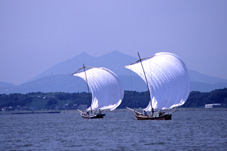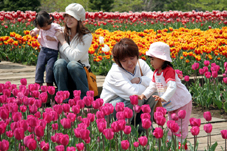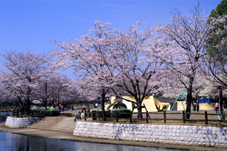Lake Kasumigaura 霞ヶ浦
Blue sky and glittering water — Kasumigaura is the second largest lake in Japan. Known as a treasure house of wild birds, it is a destination for about 150 species. In summer, sightseeing hobikisen (sail-propelled fishing boats) offer tours. The lake is also famous for fishing, attracting many fishers from all over Japan.


Yacht Harbor (Tsuchiura Port) ヨットハーバー(土浦港)
Lake Kasumigaura is a center for water sports. Built on the second-largest lake in Japan, the Kasumigaura Yacht Harbor is full of water sports fans on holidays. Noted for the good wind and wave conditions, the Harbor serves as a base for windsurfing, yachting, motor boating, and jet-skiing, attracting many people from beginners to veterans.



Tsuchiura Machikado Kura (old town storehouse) 土浦まちかど「蔵」
The Tsuchiura Machikado Kura (stores) Daitoku and Nomura stand in the old castle town’s Nakajo Street, which has been the center of commerce in Tsuchiura since the Edo period. Developed as a post station along the old Mito Kaido trunk road, this area is lined with prefecturally designated temples, shrines, and cultural properties, which preserve the traditional Edo culture, together creating a historical landscape.
■Tsuchiura Machikado Kura Daitoku (1-3-16, Chuo, Tsuchiura City: TEL: 029-824-2810) まちかど蔵「大徳」
Originally built in the late Edo period (1831) as a traditional kimono shop, the now renovated Daitoku sells local products, displays historical materials, provides tourist information, exhibits folklore materials, and serves as a residents’ meeting spot.



■Tsuchiura Machikado Kura Nomura (1-12-5, Chuo, Tsuchiura City: TEL: 029-822-0081) まちかど蔵「野村」
Built across the street from Daitoku between the late Edo and early Meiji periods (1873), Nomura displays folklore materials and serves as a residents’ meeting spot.


Kasumigaura Comprehensive Park (145, Oiwata, Tsuchiura) 霞ヶ浦総合公園
A sports and recreation park with a variety of facilities, and full of greenery and sunshine.
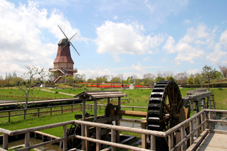

■Dutch windmill オランダ型風車
The Dutch windmill by the lake is the symbol of the park. From the top of the windmill, you can enjoy a 360-degree view, including the Tsuchiura downtown area and even the hobikisen boats with their full white sails on Lake Kasumigaura in summer.


■Tulips チューリップ
From late April to early May, about 30,000 tulips bloom around the windmill, attracting many visitors.


■Suigo People’s Lodge (255, Oiwata, Tsuchiura TEL: 029-823-1631) 国民宿舎「水郷」
Suigo, an inexpensive lodge run by the local government, serves as a base for trips to Tsuchiura. It provides a wonderful view of Lake Kasumigaura as well as river fish dishes.
(Outlook bath "kahono-yu " and Meeting facilities are open, Lodgings are closed at present.)



Kijo Park (1-13, Chuo, Tsuchiura) 亀城公園
Established on the ruins of Tsuchiura Castle, which was built in the Muromachi period (1338-1573), Kijo Park is now a place to relax. The name Kijo refers to the turtle shape of the castle in its moat. The watchtower gate is the only one of its kind that remains in the Kanto region, and is the symbol of the park. The park’s 70-odd cherry trees create a beautiful harmony with the watchtower gate and the moat.
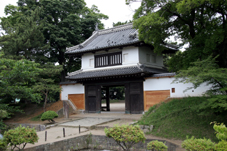

Komachi no Sato and Komachi no Yakata (491, Ono, Tsuchiura TEL: 029-862-1002)小町の里・小町ふれあい広場
Legend holds that Onono Komachi, a great beauty and distinguished poet of the Heian period (794-1192), spent her last days in Ono. Komachi no Yakata has exhibitions, a traditional central household firepit


Asahi Observation Park (Yasuragi no Mori) (1291-14, Ono, Tsuchiura) 朝日展望公園(やすらぎの森)
Lying at the foot of Mt. Tsukuba, this park is listed as one of the best 100 tourist attractions in Ibaraki Prefecture. From the observation tower, you can survey the Kanto Plain, and in fine weather, even Mt. Fuji and Shinjuku Subcenter. The park is also a Mecca for sky sports, where colorful paragliders dot the sky.


Ottonuma Park (50-10, Nakamura Nishine, Tsuchiura) 乙戸沼公園
Ottonuma Park is famous for the cherry trees that ring the pond. About 900 cherry trees draw people in blossom season. Lying in a rich natural environment, the park is home to a variety of migrant birds in winter. The walking trail around the pond offers a place to relax.


Lotus roots (Kidamari, Teno, Tamura, Okijuku, and other areas, Tsuchiura) レンコン(土浦市木田余・手野・田村・沖宿地区ほか)
Tsuchiura is the biggest lotus root (renkon) production area in Japan. Tsuchiura renkon is popular for its crunchy texture and high nutritional value. Processed foods such as udon noodles and sablé (cookies) are also available.


「Guidoor」 Multilingual tourism information
"Guidoor", a multilingual tourism information site, allows you to check the city's tourism informataion, event information, and disaster prevention information.
|
For more information, please contact the Tourism and Products Section, Department of Industry and Tourism. |
|
Tsuchiura City Office (3rd floor), 9-1 Yamato-cho, Tsuchiura 300-8686 |
|
[TEL] 029-826-1111 ext. 2705, 2706 |
|
[FAX] 029-823-9220 (common) |
|
|
